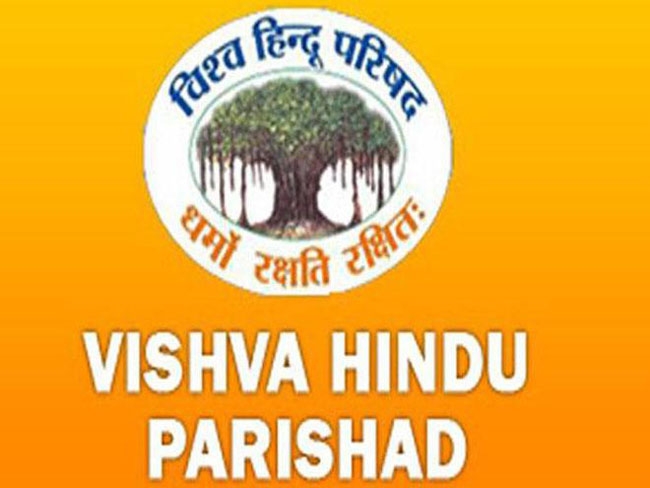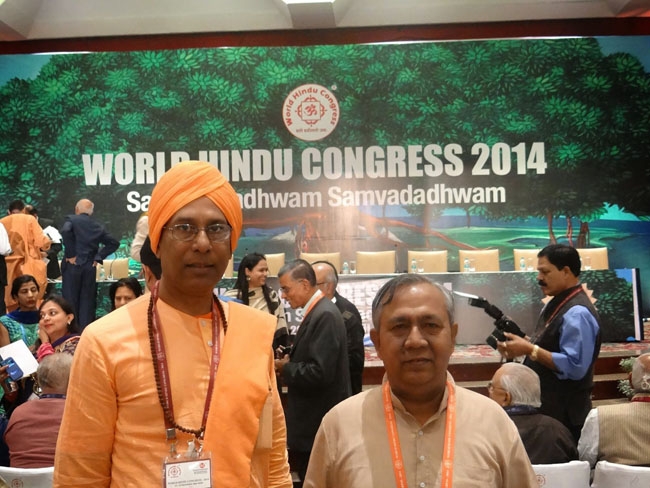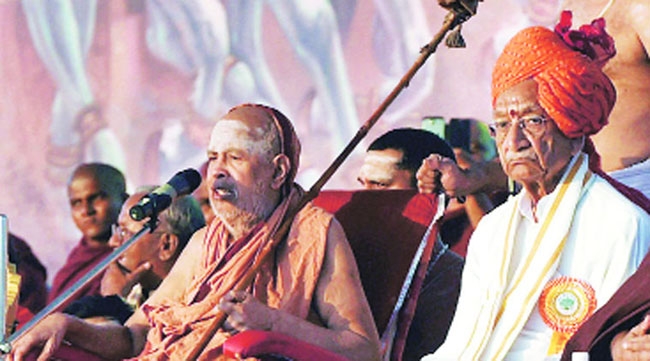VHP emerges as the most powerful voice of Hindus abroad

Vishwa Hindu Parishad (VHP), perceived as the most militant Hindu outfit in India fighting for the Ram Mandir, vigorously pursuing the ghar vapsi or reconversion agenda, and despising the non-Hindus etc. by the anglicized secular media and politicians, has, besides celebrating its 51st year, successfully entrenched itself as the powerful voice of Hindus abroad besides generating a positive receptive attitude towards Hindu dharma, ethos and values and world view amongst the global community.
Hindus constitute 1/6th of the total global population of 700 crore and live in 150 countries out of 196 nations. This means every 6th person in the world is a Hindu. Though there are 53 officially declared Muslim countries and 20 officially declared Christian countries besides over 100 Christian dominating lands, there is no country which boasts of an official status as Hindu country. Nepal was an exception until the recent past but that also no ceases to be a Hindu nation, the efforts to restore its Hindu status notwithstanding.
However, traditionally, Bharat with 79.8 per cent, Nepal with 78.5 per cent and Mauritius with 51.8 per cent Hindu population are the Hindu majority nations, but officially none of them is named as a Hindu nation.
The Hindu society known for its Holistic worldview and paradigm for the welfare of entire universe, humanity included, could not leave its impact on the global psyche as it was most disintegrated and unorganized. There was no global body which would speak on behalf of the Hindus in a most forceful manner whenever they were confronted with injustices in different lands in spite of their contributions to development and uplift of the native peoples.
Vishwa Hindu Parishad (VHP) which was founded on Sri Krishna Janmashtami Day in 1964 decided to be the voice of these Hindus. The VHP was the brainchild of second Rashtriya Swayamsevak Sangh (RSS) Sarsanghchalak M S Golwalkar, popularly and respectfully kown as “Sri Guruji”. In consultation with the saints of different sets of Hindu dharma, Golwalkar played a pivotal role in foundation of VHP in Mumbai in Swami Chinmayananda’s Sandipani Ashram on 29th August, 1964 to provide a platform to Hindus scattered worldwide that can devise and offere workable and tangible solutions to address their woes, problems and sufferings so that they can live their peacefully contributing to the overall uplift of the humanity towards highest goals in human life.
The birth of VHP was neither a reaction or response to a stimulus which would lose its vitality no sooner the stimulus is removed as it happens in many a case, nor was it a temporary outburst arising from any socio-political contingency, nor was it born out of a desire for self-aggrandizement! On the contrary it emerged out of a sense of history with Hindu unity & organization as its watchword for the progress and welfare of Bharat and by extension that of the world. VHP Karyakartas try to live the Chanakya quote: “Lead your life as if you are going to die tomorrow, but develop your society as if it’s never going to die”.
The VHP soon succeeded in establishing National Chapters in the USA, the U.K., Canada, Norway, Denmark, The Netherlands, Germany, Hong Kong, Australia, Sri Lanka, Suriname, Trinidad & Tobago, Guyana, that are incorporated as per law in those countries as non-profit charities. Here an attempt is made to introduce the activities VHP has been doing outside Bharat in uniting the Hindus.
VHP in USA: The United States of America (USA) today is the world’s Super Leader. A nation born some four centuries ago is now virtually controlling the global affairs in every respect. Hindus constitute about 2.4 million of the total 320 million. It has 1600 tempels, and many Hindu religious and social organizations like Sanatana Sharma Sabha, Arya Samaj, R K Mission, ISKCON, Chinmany Mission, and so on. Hindus in USA are positioned in most respectable professions as technicians, IT professionals, doctors, engineers, scientists, teachers, businessmen etc. Recently, the Indians there have made their presence felt in the decision-making bodies of that country.
The VHP of America (VHPA) began its work in 1970 in New York. It now has 14 chapters. The VHPA targeted the children and youth with their unique and attractive programs aimed at making them understand the glory of Hindu philosophy and behaviour. The annual Hindu Mandir Executives’ Conference (HMEC) started by VHPA is now a resounding success story.
At present the Hindu-Americans hold highest socio-economic levels in the USA due to their highest rate of educational attainment and earnings. According to Pew Research Center’s Forum on Religion and Public Life study in 2012 48 per cent of Hindu-Americans have household income of $100,000 or more with 70 percent of them earning $75000, which is highest amongst all religions in the USA.
The Hindu Americans have left a mark of many of the Hindu concepts such as Karma, Reincarnation, and now Yoga. According to Newsweek survey, 24 percent Americans now believe in reincarnation which is a core concept of Hindu dharma. The response to International Day of Yoga on 21 June this year underlined the impact of Hindu ideas on the American psyche.
In the last four decades the VHPA has undertaken some 30 plus major initiatives and programs towards fulfilment of its objectives such as heritage camps and conferences in which over 30000 youth enrolled their participation. Bal Vihar is another such event started to impart Hindu samskars and life values amongst the children to discover their cultural bond with Bharat and develop pride in their Hindu identity. The HEMC is a network of Hindu Mandirs in USA which explores the ways of anchoring eternal values of Hindu Dharma in the hearts of coming generations and the role of temples in this mission. Hindu Conference began in 1984, Dharma Sansad (Parliament of Religion), ZDharma Prasar Yatra and Viswa Dharma Prasar Yatra have been major milestones in the history of VHPA.
The VHPA played a crucial role in founding of Hindu University of America (HUA), Hindu Students’ Council, HinduNet and giving birth to Hindu Activism on the Web in the form of AHAD. It also runs a number of service projects such as Support a Child (SAC) that provides for living and educational needs of hundreds of children in Bharat. The Ekal Vidyalaya Program of VHPA focuses on mass education and health care in Janjati (tribal) areas of Bharat. The VHPA reconstructed the entire village of Lodai in Gujarat that was destroyed in the devastating earthquake of 2000 and built boats for tsunami-hit fishermen.

Sewa in America offer services through Homeless Soup Kitchen, Adopt a Highway, Blanket distribution, Ashraya, Bhutanese Resettlement project, Katrina, Haiti, Chile and Japan disaster relief, providing priest services, and so on. VHPA members believe: “We brought with us to this land, our value system, our family structure and our spiritual life style. These are the only treasures that our Rishis gave us to live by and to share with others leaving the world a better place than we found it.”
Guyana and Suriname: Though Hindus have scattered presence in South America they are stronger in Guyana and Suriname. There are about 400,000 Hindus in South America, mostly descendents of Indian indentured labourers who hailed from Uttar Pradesh, Bihar and Odisha states some 150-200 years ago. The Hindu population in Guyana is around 270,000 that has a total population of 7.57 lakh. Hindus form 35 percent of the total population and Bharrat Jagdeo had been its president. The present incumbent is Donald Ramotar.
In Suriname the Hindus constitute 1.25 lakh out of the total population of 5 lakh. The VHP started Western Hemisphere Kumbh Mela christened it as ‘Surya Kumbha Parva” which is held on Makar Sankranti (14th January) to 18th February on the banks of river Suriname. The occasion of Deepavali is also celebrated which is graced by the President of Republic of Suriname in 2011. The Deepavali Diya (lamp) has become a national monument and the Hnidu community gets Deepavali as a national holiday.
Trinidad & Tobago: This is country of islands in the West Indies with a total Hindu population of around 3 lakh. They are the descendents of plantation labourers brought here by the colonial rulers from UP, Bihar and other states some 150 years ago. The VHP organized a World Hindu Conference in 2000 and under its auspices the Hindus of Trinadad constructed the magnificent temple of ‘Trinidadeshwar Mahadeva’.
They even consecrated a river with the holy Ganga Jal and waters of other holy rivers of Bharat and renamed it as “Ganga Dhara”. Thousands of Hindus gather every year to celebrate Ganga Dashahara and Kartik Snaan on the bank of this river. Trinadad also hosts the 85-feet Hanuman idol famous in the Western Hemisphere.
The African Nations: Kenya, Mauritius, South Africa are some of the countries where the VHP has done commendable work for the Hindus. In Kenya the Hindu Council of Kenya works in tandem with VHP to organize Hindus.
Mauritius has over 51 per cent Hindus and various Hindu organizations including Sanatana Dharma Sabha, Arya Samaj, Chinmaya Mission, R K Mission are active amongst the Hindus. The VHP here is a registered body. The Hindus have better political influence here and the Prime Minister of this country has been a Hindu except for one term. It is one of the three countries in the world where Hindus are a dominant people. All Hindu festivals are celebrated in the most enthusiastic manner with the participation of all the Hindus.
In South Africa Hindus are over 11 lakh whose ancestors had been brought here as plantation labourers by the colonial rulers one and a half century ago. With the help of ‘Ramcharitmanas’ and their unshakable faith in Hindu dharma, they withstood all the vagaries and adversaries in their life. Durban is the main centre where Hindus have major concentration. Here the VHP had organized a World Hindu Conference in 1995 which was attended by Nelson Mandela among others.
VHP in European lands: European continent too has sizeable presence of Hindus in different countries, the United Kingdom being the most important of them. The VHP has done good job in organizing Hindus in Denmark, Germany, Holland, Norway, and the UK. The activities mostly are concentrated on organizing Hindu conferences, organizing students, and holding camps and celebrating festivals.
In the UK, the VHP has established good rapport with the local administration. It has forcefully articulated the case of Hindus from Fiji and Bangladesh with the Commonwealth, UNO, Amnesty International, Interfaith organizations. There are around 12 lakh Hindus in the UK and the VHP started working there in 1972 and now has 12 chapters. The VHP takes lead in organizing festivals of Krishna Janmashtami, Ram Navami, Navaratri, Diwali in a big way. Annual camps for children, youth, Virat Hindu Conferences, etc. It has brought out a guideline book “Explaining Hindu Dharma – A Teacher’s Guide” that is recognised by the British Government as a text book to teach Hindu Dharma in schools.

The Pacific region: The VHP also entered in the Pacific region and set up its chapters in Australia, New Zealand, and Fiji islands. In Australia the Hindus are a religious minority but according to 2011 census Hinduism is the fastest growing religion there. VHP Australia has been trying to shape the Hindu identity and position of Hindus in Australia through various activities like National Hindu Conferences. It participated in the World Parliament of Religions in 2009 at Melbourne. VHP activists are teaching Hindu Dharma in 60 schools; it also runs Veda Pathshalas at Sydney which is a unique project.
VHP runs other important projects such as Bal Sanskar Kendra, Children Camps, Hindu Heritage camps, Hindu Social Service Foundation. Hindu Youth Australia (the youth wing of VHP) held the 1st Australian Hindu Youth Conference on April 19-20, 2008 on the theme “Contribution of Hindu community in Australia”. This conference was welcomed by the government of Australia and they reported at their official website: “Hindu Youth inspired the nation through leadership and cohesion”.
The Hindu Youth Australia held its 2nd National Conference on Sunday, 7 August 2011, in Parramatta, in western Sydney. The conference was titled “Create, Connect, Commit”, a call to action to 250 young Hindu Australian attendees, to be proactive and visible in their contribution towards the greater Australian community.
The conference was endorsed by the Prime Minister Julia Gillard MP, who in her message of support, highlighted the positive contributions of Hindu Australians, and encouraged young Hindus in Australia to do the same. This sentiment was echoed in the addresses given by Ms Julie Owens MP and Mr Laurie Ferguson MP, who were both present and have been regular attendees at various Hindu conferences. VHP here celebrates Varsha pratipada (Hindu New Year Day) and Sri Ram Navami. The Ekal Vidyalaya foundation is active here.
In the Fiji Islands the Hindu are 40 per cent of the total population with many Hindu associations working amongst them. However, under the weight of frequent coups the Hindus have lost their political influence to a considerable extent. During the 1990s the Hindus had to bear the brunt of riots by radical Fijians. Volunteers of Vishwa Hindu Parishad-Fiji as HEART (Hindu Emergency Aid Relief Team) have been active in relief and rehabilitation missions in the cyclone affected areas.
In New Zealand the Hindus are 65000 and since 2006 Hindu Council of New Zealand is working amongst them. Immediately after registration, they purchased the old campus of the New Zealand University in Auckland measuring an area of 8.5 acres of land including the buildings and other infrastructure and established Hindu Heritage Centre. The government now holds VHP in high esteem and given it charity status. VHP-NZ has created a Hindu movement in New Zealand and has achieved many a milestone in building organizations and also shaping Hindu identity, strengthening and positioning Hindu community through organizing national and regional conferences, youth conferences, elder conference, seminars, children and youth camps, unique Deepawali festivals, transforming the Raksha Bandhan festival as an instrument in organizing Hindu community there.
The first conference of VHP was inaugurated by the Prime Minister Ms Helen Elizabeth Clark. VHP has also set up many sister organizations for youths, students, elders, Hindu emergency aid and relief team (HEART), to work amongst the Hindus and natives.
VHP in Asian lands: Asia has been the home to many religions of the world. Hindu, Bouddha, Jain, Sikh, Shinto, Confucian, Parsis, Judaism, Islam and other religions are born in the Asian lands, Hindu Dharma being the major one amongst them. It was therefore natural that the VHP found most fertile atmosphere in the Asian countries of Bhutan, Nepal, Indonesia, Malaysia, Sri Lanka, Myanmar, Singapore and Thailand. Most of these countries either profess Hinduism or Buddhism in some form. The VHP organised an International Hindu Youth Conference in 2004 in Bali after the first Bali bombings. In Malaysia, the VHP is fighting for the rights of the Hindus under the banner of HINDRAF. But it is facing difficulties due to Islamic influence on the government and administration.
In Myanmar the VHP works with Sanatana Dharma Swayamsevak Sangh, a prominent organization of Hindus. In Nepal, it has good network and Ekal Vidyalaya scheme is functioning well in Nepal with 355 schools. Health services are provided to over 135,000 patients. In Sri Lanka the Hindus are around 25-30 lakh. Due to civil war like situation the work of VHP was affected. But VHP was reorganized in 2001 and its activities were given a boost. It was registered again. Many youth camps were organised on a continuous basis. Sunday Hindu schools are being run. Ganesh festivals at mass level are being organised, propagated and spread. “Bharatiya Hindu Association” has been established to consolidate the Hindus that have gone there for employments and business.
Thailand is another country with Hindu influence. The VHP Thailand organizes several Hindu festivals such as Holi, Deepwali, Ganesh Chaturthi, etc. Ganesh Puja is jointly organized together with Buddhist temple and monasteries. Organizing Ganesh Festival has become a landmark achievement of VHP Thailand and this festival has become an instrument of togetherness of both Hindu and Buddhist communities there.
(Inputs from VHP website)

